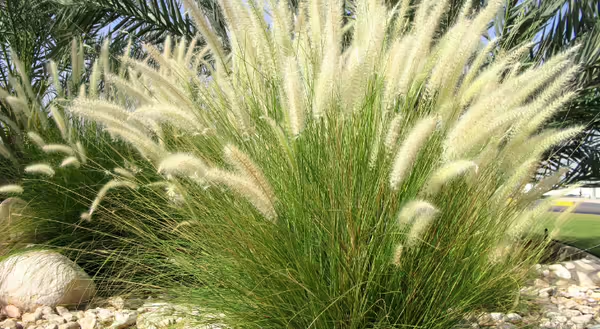
As the gardening season approaches, many gardeners are starting to think about potential changes to their landscaping or flower beds to make them more eye-catching or easier to maintain. Consider adding ornamental grasses to your landscape to captivate your garden visitors while establishing a planting that is limited maintenance, tough, and dependable. Ornamental grasses can enhance the architecture of an outdoor space and create a natural fence for an added sense of privacy. A once motionless foundation planting can be transformed into an attention-grabbing, curb-appealing space that welcomes visitors by creating an added layer of beauty with its airy structure.
Grasses are classified as either warm season or cool season, depending on when they start to grow. Cool-season grasses start to grow in early spring when temperatures are still mild. They do best when watered during dry periods and may go dormant, or develop brown foliage, during excess heat or drought. They should be cut back in late winter or early spring, leaving a few inches of foliage above the ground. Examples of cool-season grasses are blue fescue, feather reed grass, and Autumn moor grass.
Warm-season grasses do not begin to grow until the soil warms up in late spring. Once they are established, they become tolerant to drought and heat. Many warm-season grasses will have gorgeous brown or burgundy fall colors lasting into the winter. Cut these grasses back to four to six inches above the ground in the spring before new foliage develops. Examples of warm-season grasses for the landscape are switchgrass, little bluestem, fountain grass, hakone grass, Northern Sea oats, and Japanese silver grass.
Ornamental grasses can develop two different growth habits depending on the grass, either clump forming or rhizome forming. As the name suggests, the clump-forming grasses will grow in orderly clumps or mounds. Rhizome-forming grasses are typically not enjoyed in the landscape because they can become aggressive and invasive. They reproduce through underground stems which can develop quickly and are difficult to control. Use caution when planting these types of grasses or avoid them entirely! Examples include blue lyme grass, cordgrass, and reed canary grass.
Ornamental grass care is simple. Supplemental fertilization is not necessary, but slow-release fertilizer in the spring benefits new foliage growth. Ornamental grasses should be divided every few years to keep the plants actively growing and healthy. Plants that do not get divided regularly will die out in the center, creating a donut-shaped plant. It’s best to divide plants in early spring before new growth begins and plant divisions in new garden beds.
Ornamental grasses add movement to a rigid landscape. The tall stems and blades, and airy seed heads create a wave of foliage in the wind. These grasses can vary widely in height, color, texture, structure, and seed head shape. With four seasons of interest, they are a must for any landscape. Whether edging along a path, designing a focal plant in the landscape, or growing a row of plants for a screen, ornamental grasses can be a valuable addition to any garden.